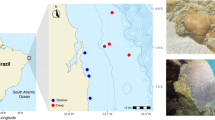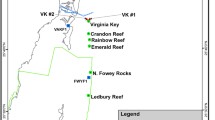Abstract
The abundance and distribution of black band disease on the reef building coralsMontastraea annularis, M. cavernosa, Colpophyllia natans, Diploria clivosa, D. labyrinthiformis andD. strigosa were determined at Algae Reef, Grecian Rocks and Key Largo Dry Rocks in the Key Largo National Marine Sanctuary, Florida, USA. During July and November of 1992 and July 1993, surveys of permanently marked sites covering 9424m2 of reef tract showed that up to 0.72% of 1397 coral colonies of these species were infected with black band disease. The distribution of the disease among the thirty 20-meter diameter sites was clumped, suggesting that the disease is infectious. Year-round monitoring revealed that seasonal disease patterns varied between reefs. Three seasonal patterns were apparent: some coral colonies were infected year round; several colonies exhibited previously unreported reinfection on a seasonal basis; and some exhibited the widely reported pattern of infection limited to the warmer months of the year (sea water temperatures 25 °C or higher).
Similar content being viewed by others
References
Antonius A (1973) New observations on coral destruction in reefs. 10th Meeting Assoc Isl Mar Lab Carib 10:3 (abstr)
Antonius A (1977) Coral mortality in reefs: a problem for science and management. Proc 3rd Int Coral Reef Symp 2:3–6
Antonius A (1981a) Coral reef pathology: a review. Proc 4th Int Coral Reef Symp 2:3–6
Antonius A (1981b) The “Band” diseases in coral reefs. Proc 4th Int Coral Reef Symp 2:7–14
Antonius A (1985a) Coral diseases in the Indo-Pacific: a first record. PSZNI Mar Ecol 6:197–218
Antonius A (1985b) Black band disease infection experiments on hexacorals and octocorals. Proc 5th Int Coral Reef Symp 6:155–160
Antonius A (1988) Distribution and dynamics of coral diseases in the eastern Red Sea. Proc 6th Int Coral Reef Symp 2:293–298
Carlton R, Richardson L (1995) Oxygen and sulfide dynamics in a horizontally migrating cyanobacterial mat: black band disease of corals. FEMS Microb Ecol 18:155–162
Ducklow H, Mitchell R (1979) Observations on naturally and artificially diseased tropical corals: a scanning electron microscope study. Micro Ecol 5:215–223
Dustan P (1977) Vitality of reef coral populations off Key Largo, Florida: recruitment and mortality. Environ Geol 2:51–58
Dustan P, Halas JC (1987) Changes in the reef-coral community of Carysfort Reef, Key Largo, Florida: 1974–1982 Coral Reefs 6:91–106
Edmunds PJ (1991) Extent and effect of black band disease on a Caribbean reef. Coral Reefs 10:161–165
Feingold JS (1988) Ecological studies of a cyanobacterial infection on a Caribbean sea plumePseudopterogorgia acerosa (Coelenterata: Octocorallia) Proc 6th Int Coral Reef Symp 3:157–162
Garrett P, Ducklow H (1975) Coral diseases in Bermuda. Nature 253:349–350
Gladfelter WB, Gladfelter EH, Monahan RK, Ogden JC, Dill RF (1977) Environmental studies of Buck Island Reef National Monument, St. Croix US Virgin Islands. Spec Rep Nat Park Serv US Dept Int, p 173
Peters EC (1984) A survey of cellular reactions to environmental stress and disease in Caribbean scleractinian corals. Helgol Wiss Meeresunters 37:113–137
Peters EC (1988) Symbiosis to pathology:are the roles of microorganisms as pathogens of coral reef organisms predictable from existing knowledge? Proc 5th Int Coral Reef Symp 1:205–209
Peters EC (1993) Diseases of other invertebrate phyla: Porifera, Cnideria, Ctenophora, Annelida, Echinodermata. In:Couch JA, Fournie JW (eds) Advances in fisheries science. Pathobiology of marine and estuarine organisms. CRC Press, Boca Raton Ann Arbor London Tokyo, pp 393–441
Porter JW, Meier OW (1992) Quantification of loss and change in Floridian reef coral populations. Am Zool 23:625–640
Ramos-Flores T (1983) Lower marine fungus associated with black line disease in star corals (Montastrea annularis E. & S.) Biol Bull 165:429–435
Richardson LL (1992) Red band disease: a new cyanobacterial infestation of corals. AAUS Diving for Science 10:153–160
Richardson LL (in press) Occurrence of the black band disease cyanobacterium on healthy corals of the Florida Keys. Bull Mar Sci (in press)
Rutzler K, Santavy DL (1983) The black band disease of Atlantic reef corals I. Description of the cyanophyte pathogen. PSZNI Mar Ecol 4:301–319
Rutzler K, Santavy DL, Antonius A (1983) The black band diseases of Atlantic reef corals. III. Distribution, ecology and development. PSZNI Mar Ecol 4:329–358
Shinn EA, Lidz BH, Kindinger JL, Hudson JH, Halley RB (1989) Reefs of Florida and the Dry Totugas Miami to Key West, Florida July 2–7,1989. In: Field Trip Guidebook T176 American Geophysical Union, Washington, D.C. pp 1–50
Szmant-Froelich A (1985) The effect of colony size on the reproductive ability of the Caribbean coralMontastrea annularis (Ellis and Solander). Proc 5th Int Coral Reef Symp 4:295–300
Taylor DL (1983) The black band disease of Atlantic reef corals. II. Isolation, cultivation, and growth ofPhormidium corallyticum. PSZNI Mar Ecol 4:321–328
Weil E, Knowlton N (1994) A multi-character analysis of the Caribbean coralMontastraea annularis (Ellis and Solander,1786) and its two sibling species,M. faveolata (Gregory, 1895). Bull Mar Sci 55:151–175
Author information
Authors and Affiliations
Rights and permissions
About this article
Cite this article
Kuta, K.G., Richardson, L.L. Abundance and distribution of black band disease on coral reefs in the northern Florida keys. Coral Reefs 15, 219–223 (1996). https://doi.org/10.1007/BF01787455
Received:
Accepted:
Issue Date:
DOI: https://doi.org/10.1007/BF01787455




